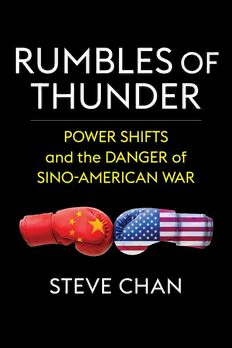
Rumbles of Thunder: Power Shifts and the Danger of Sino-American War PDF
Preview Rumbles of Thunder: Power Shifts and the Danger of Sino-American War
RUMBLES OF THUNDER RUMBLES OF THUNDER P OW E R SH I F T S and the DA N G E R O F SI N O - A M E R IC A N WA R STEVE CHAN Columbia University Press New York Columbia University Press Publishers Since 1893 New York Chichester, West Sussex cup . columbia . edu Copyright © 2023 Columbia University Press All rights reserved Library of Congress Cataloging- in- Publication Data Names: Chan, Steve, author. Title: Rumbles of thunder : power shifts and the danger of Sino- American war / Steve Chan. Description: New York : Columbia University Press, 2022. | Includes bibliographical references and index. Identifiers: LCCN 2022014295 (print) | LCCN 2022014296 (ebook) | ISBN 9780231208444 (hardback) | ISBN 9780231208451 (trade paperback) | ISBN 9780231557436 (ebook) Subjects: LCSH: Balance of power. | War— Causes. | United States— Foreign relations— China. | China— Foreign relations— United States. Classification: LCC JZ1313 .C475 2022 (print) | LCC JZ1313 (ebook) | DDC 327.1/12— dc23/eng/20220701 LC record available at https:// lccn . loc . gov / 2022014295 LC ebook record available at https:// lccn . loc . gov / 2022014296 Columbia University Press books are printed on permanent and durable acid-f ree paper. Printed in the United States of America Cover design: Milenda Nan Ok Lee Cover image: Decha Anunthanapong/Alamy Stock Photo CONTENTS INTRODUCTION 1 1. POWER SHIFT EXPLAINS BETTER WORSENING SINO- AMERICAN RELATIONS 43 2. CONCEPTUAL AND MEASUREMENT PROBLEMS IN STUDYING POWER 85 3. PERSISTENCE OF WASHINGTON’S STRUCTURAL POWER IN U.S. GLOBAL DOMINATION 111 4. DOMESTIC SOURCES OF FOREIGN POLICY 142 vi(cid:2)CONTENTS 5. TAIWAN AS A POSSIBLE CATALYST FOR SINO- AMERICAN CONFLICT 176 CONCLUSION 206 Acknowledgments 233 Notes 235 Bibliography 277 Index 307 RUMBLES OF THUNDER INTRODUCTION T his book challenges much of the received wisdom about Sino- American relations. It will likely be a source of discomfiture, irri- tation, and even sharp disagreement for many readers. If it is, it will thus offer an opportunity for a vigorous debate. As a Wall Street pun- dit supposedly said, “I become worried when everyone gets to one side of the boat.” Even smart people can sometimes become victims of what we now know as groupthink.1 Scholars, no less than people in other profes- sions, can exhibit conformity to conventional thinking and narratives. We see nowadays elite and public opinion coalescing in both China and the United States about the other country’s inherent hostility and bad faith and the need to take a tougher stand against it. This is the stuff that con- tributes to a conflict spiral, each side developing a mirror image of the other. The silencing of dissident voices, whether by self- censorship or oth- erwise, abets a sense of self- righteousness, contributing to an escalation of mistrust and tension. Hard- liners in each country become their coun- terparts’ best allies as their reciprocal recrimination feeds on each other. Readers of this book will find many contrarian views challenging main- stream ideas circulated in popular media and academic discourse. Americans will find contradictions to their self- image of the United States as a benevolent, rule- abiding, and status- quo hegemon. The idea that dem- ocratic politics, sometimes reflected in populism, is likely to hamper rather than contribute to easing Sino- American tension is also likely to 2(cid:2)INTRODUCTION be controversial, even abhorrent, to many American readers. They will find in the following pages criticisms of their country’s crusader impulse to convert the world in its image and their leaders’ double standards in constructing narratives about Sino- American relations. Many will also likely object to the claim that the United States has in recent years acted more like a revisionist power than China, and that it has done so more assertively and aggressively than China. At the same time, Chinese readers will be disappointed to hear that it is still a world dominated by the United States and that it will remain so for some considerable time to come. Moreover, they will be disturbed to hear of a pervasive negative image of China in foreign countries— even though foreigners’ trust and confidence in the United States also plum- meted during the Donald Trump administration and despite popular skepticism about and even resistance to democratic and capitalist insti- tutions.2 China’s values and identities do not appeal to many people in other countries.3 Despite the supposed success of its development model, Beijing cannot compete with Washington’s soft power.4 Its actions in Xin- jiang and Hong Kong and toward Taiwan lead foreigners to see China in a negative light. A country that mistreats its own citizens cannot reassure foreigners that they will receive better treatment. This observation also applies to the United States given its persistent racial inequities and dis- crimination that have spurred mass protests such as the Black Lives Mat- ter movement. What citizens and pundits say about another country often reveals more about themselves than the subject of their commentary. Andrew Bacevich observes that “American statecraft is not, in the first instance, about ‘them;’ it is about ‘us.’ ”5 Hubris, prejudice, excessive confidence, overweening ambition, and scapegoating and stereotyping are on display on both sides of the Pacific. These human tendencies are in the final anal- ysis the ingredients that can precipitate a dangerous confrontation. After all, people rather than structural conditions make decisions. The perti- nent structural conditions include not just what is happening at the inter- state level of analysis, such as the shifting power balance between two countries. The domestic alignments of political power and interests are also pertinent. They can alter the nature of political discourse by empow- ering hard- liners whose rhetoric gives further fuel to popular grievances and self- righteousness.6
